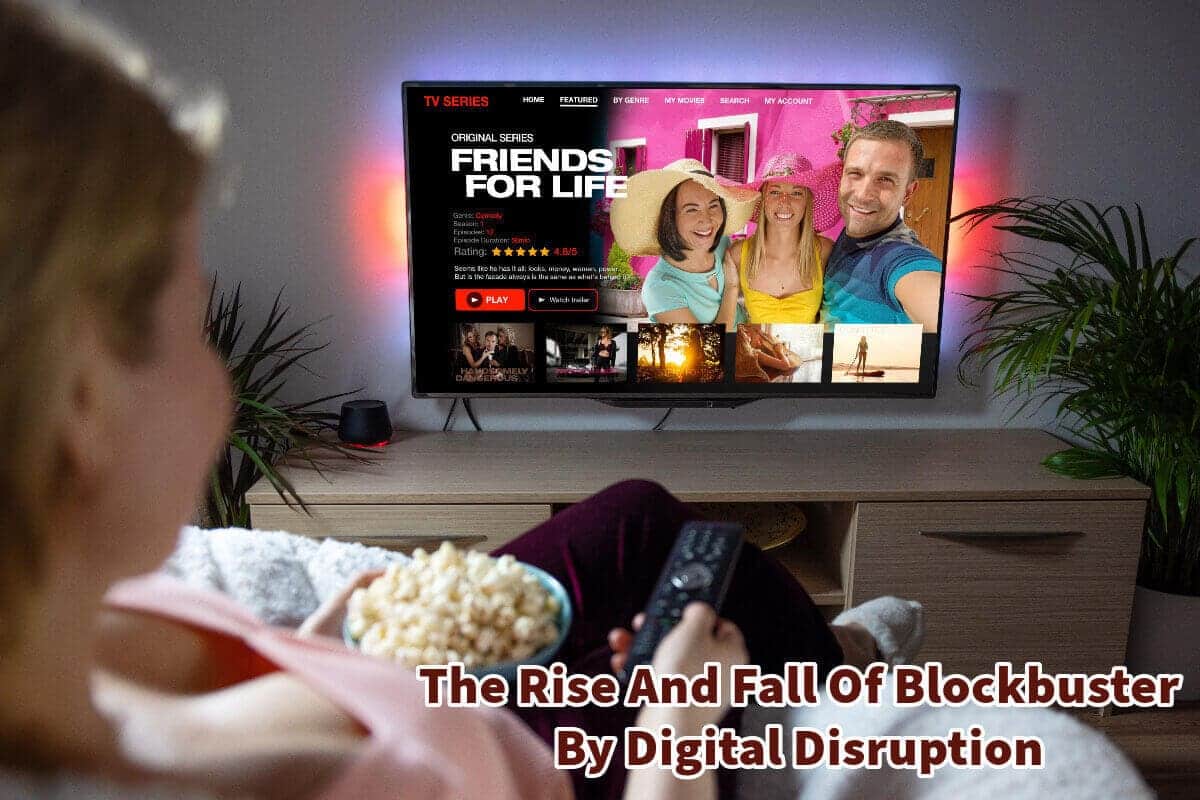I can still recall the simple pleasure of strolling down the aisles of a Blockbuster store, scanning through shelves full of VHS tapes or DVDs, and picking out a few to enjoy a movie night at home. Those moments now feel like a distant memory.
Blockbuster, once a cornerstone of family entertainment, has become obsolete, eclipsed by giants like Netflix and Amazon Prime Video. Continue reading as we delve into the captivating story of Blockbuster’s rise and fall in the age of disruptive innovation and what every business can learn from this tragic story.
Table of Contents
- The Fall Of Blockbuster: A Cautionary Tale Of Digital Disruption And Missed Opportunities
- Netflix Enters The Scene
- The Missed Opportunity: Blockbuster’s Failure To Partner With Netflix
- The Lessons To Learn From Blockbuster And Netflix
- Understanding Digital Disruption: Clay Christensen’s Concept
- Related Content
The Fall Of Blockbuster: A Cautionary Tale Of Digital Disruption And Missed Opportunities
The collapse of Blockbuster, once a behemoth in the video rental industry, serves as a textbook example of how traditional market leaders can be decimated by disruptive innovation. This demise was accelerated by a failure to adapt to change and underestimate new entrants—in this case, Netflix.
Such examples aren’t limited to Blockbuster. Giants like Kodak, Nokia, and Motorola met similar fates for similar reasons. Meanwhile, tech-driven companies like Apple, Amazon, Google, Netflix, and Facebook have collectively generated more than $4 trillion in market value by embracing innovation and disrupting traditional business models.
A Brief History Of Blockbuster’s Rise
Founded in 1985 by David Cook, a software engineer, Blockbuster started as a single store in Dallas, Texas, with an inventory of 8,000 VHS tapes—a stark contrast to competitors offering around 1,000 titles.

By 1988, Blockbuster was the leading video rental chain in the U.S., with over 800 stores. A 1994 acquisition by Viacom helped the company scale even further.
By 2004, Blockbuster was at its zenith with a valuation of $5 billion and more than 9,000 stores worldwide. But six years later, the company filed for bankruptcy, its market value a paltry $24 million.
Netflix Enters The Scene
While Blockbuster was enjoying its heyday, a startup named Netflix emerged in 1997. Unlike Blockbuster, Netflix didn’t rely on brick-and-mortar stores. It adopted a unique model of mailing DVDs to customers’ homes via the low-cost U.S. Postal Service, avoiding late fees, a sore point for Blockbuster customers.
Blockbuster and Netflix operated without directly competing, targeting different customer bases and offering distinct experiences for many years.

The Turning Point: Streaming Takes Over
However, with the rise of internet bandwidth and streaming technology, Netflix evolved its business model. What began as a mail-based rental service quickly transitioned to a streaming platform offering on-demand, high-quality, low-cost service—directly challenging Blockbuster’s core value proposition.
The shift was gradual, but Blockbuster remained focused on its physical stores, neglecting the opportunities that digital transformation provided.
The Missed Opportunity: Blockbuster’s Failure To Partner With Netflix
Ironically, Netflix’s co-founder Reed Hastings approached Blockbuster’s then-CEO John Antioco with a partnership proposal. The idea was that Netflix would handle Blockbuster’s online business while Blockbuster would promote Netflix in its stores.
Blockbuster declined, not seeing Netflix as a threat. This decision would prove to be a fatal error. By 2010, Blockbuster was bankrupt, while Netflix was valued at more than $25 billion.
Why Blockbuster Failed To Innovate?
One of the most common pitfalls for industry leaders like Blockbuster is complacency. A history of success can create a false sense of security, undermining the urgency to innovate and adapt.
This complacency can manifest as incrementalism, where organizations focus on minor tweaks to existing services rather than anticipating future market shifts. This perspective led Blockbuster to underestimate the disruptive potential of digital technology, particularly streaming services.
Instead of considering the digital landscape an opportunity, they saw it as a niche market not worth their attention.

The Lessons To Learn From Blockbuster And Netflix
The Blockbuster-Netflix saga serves as a cautionary tale for businesses in all sectors. Today, technology and digital transformation are reshaping industries at an unprecedented rate, making innovation a necessity rather than an option.
Television networks and cable companies, who once had a near-monopoly over content, have also been impacted by this disruption. They stuck to their outdated business models for too long, giving way to more agile, customer-centric platforms like YouTube, Amazon, and, yes, Netflix.
For executives, the takeaways are clear: underestimating the potential of digital disruption is risky business. The reluctance to embrace new technologies and models can hinder growth and jeopardize the company’s survival.
Blockbuster’s failure to recognize Netflix as a formidable competitor and its resistance to adapt to a digital transformation are hard lessons that current business leaders should not forget.
It’s a reminder that complacency is the enemy in today’s fast-evolving business landscape. Companies must be willing to disrupt their business models to adapt to new technologies and consumer behaviors. Failure to do so can lead to the fall of even the mightiest giants—as the decline of Blockbuster painfully illustrates.
Understanding Digital Disruption: Clay Christensen’s Concept
In today’s rapidly evolving world, understanding Clay Christensen’s concept of digital disruption is more crucial than ever. It’s not just a buzzword; it’s a transformative force reshaping industries and businesses. Let’s dive into what digital disruption is, why it’s vital to grasp, and its significance in our modern landscape.
Defining Digital Disruption:
Digital disruption, as conceived by the late Harvard Business School professor Clay Christensen, refers to the phenomenon where innovative digital technologies and business models disrupt existing markets and value networks. In simple terms, it’s when new digital solutions radically change the way we do things, often rendering traditional approaches obsolete.
Why Digital Disruption Matters:
- Accelerated Change: Digital disruption accelerates the pace of change in industries. New technologies and startups can quickly gain market share, forcing established companies to adapt or risk obsolescence.
- Market Transformation: Understanding digital disruption is essential for businesses to stay competitive and relevant. It helps them anticipate and respond to market shifts, preventing them from being left behind.
- Consumer-Centricity: Digital disruption often places consumers at the center. It leads to improved customer experiences, as new technologies offer more convenient, efficient, and personalized solutions.
- Innovation Catalyst: Digital disruption fosters innovation. It encourages companies to rethink their processes, products, and services, leading to breakthroughs and improved efficiency.
- Access to New Markets: It can create opportunities to tap into previously inaccessible markets or demographics. For example, e-commerce opened global markets to small businesses.
- Economic Growth: Digital disruption can stimulate economic growth by creating new industries and jobs, driving entrepreneurship, and increasing productivity.
- Disruption as an Opportunity: Businesses that understand digital disruption can leverage it as an opportunity rather than a threat. They can proactively innovate and adapt to capture new markets.
- Resilience: In an era marked by uncertainty and unexpected events, businesses that grasp digital disruption are more resilient. They can pivot and adapt to changing circumstances more effectively.
- Global Connectivity: Digital disruption is a global phenomenon, connecting businesses and consumers worldwide. Understanding it is essential for companies with international ambitions.
- Societal Impact: Beyond business, digital disruption influences society, education, healthcare, and more. It’s important for individuals to comprehend these changes to navigate a digitalized world effectively.
In today’s world, where technology evolves at an unprecedented rate, grasping the concept of digital disruption is not merely an advantage but a necessity. It empowers businesses and individuals to embrace change, harness innovation, and thrive in an ever-transforming digital landscape.
By understanding and adapting to digital disruption, we can turn uncertainty into opportunity and lead the way in shaping our future.
Find out more about how Mondoro can help you create, develop, and manufacture excellent home decor and home furniture products – don’t hesitate to contact me, Anita. Check out my email by clicking here or become a part of our community and join our newsletter by clicking here.
Mondoro gives out a FREE Lookbook to anyone interested. You can receive a copy of our latest Lookbook by clicking here.
Listen to our Podcast called Global Trade Gal. You can find it on all major podcast platforms. Try out to listen to one of our podcasts by clicking here.
Subscribe to our Mondoro Company Limited YouTube Channel with great videos and information by clicking here.
Related Content
7 Reasons To Use A Clear Coat On Gold Leaf
The gold leaf material is very fragile, so a clear coat will help to protect the gold leaf surface. A clear coat also toughens up the surface and helps slow oxidization. A clear coat on the gold leaf can also help us control the shine level we want on the gold leaf. You can manipulate the gold leaf with a clear topcoat on the gold leaf finish.
You can learn more by reading our blog, 7 Reasons To Use A Clear Coat On Gold Leaf, by clicking here.
When Retailers And Vendors Do Not Coordinate Their Supply Chain Management
When retailers and vendors do not coordinate their supply chain management, there can be chaos in the supply chain that can affect everyone. What happens in one part of the supply chain can have a massive impact on another; this is known as the Bullwhip Effect. Cooperation with programs like CPFR, vendors, and retailers better coordinate their activities.
To find out more, you can read When Retailers And Vendors Do Not Coordinate Their Supply Chain Management by clicking here.
What Can Be Made From Recycled Wood? Home Furniture Products We Love
Recycled wood can be used for all kinds of recycled wood furniture products. Recycled wood must be collected and sorted, and processed. But when working with recycled timber, there are some things that you need to remember, such as the furniture will have some marks, distressing and even holes in the wood.
You can find out more by reading What Can Be Made From Recycled Wood? Home Furniture Products We Love by clicking here.

